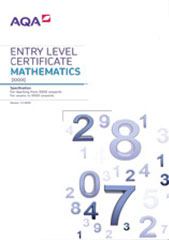3.6 Component 6: measures
This content aims to develop the student’s understanding and use of measures.
Students will learn through practical activities about methods used to measure length, weight and capacity using standard and non-standard units. They will begin to convert units of length, weight and capacity and learn how to read scales of measurement. They will also learn to compare temperature including temperature with negative values.
Procedures for making and recording assessments
Class work assessed by the teacher in response to the outcomes in the table, or assessed by an externally set assignment.
Outcomes to be accredited
In successfully completing this component, students will have demonstrated the ability to:
Entry 1
|
Outcomes |
Notes/examples |
GCSE reference |
|---|---|---|
|
1.1 Compare lengths, heights, weights and capacities |
Key words are long, longer, short, shorter, tall, taller, heavy, heavier, light, lighter, more, less, most, least |
|
|
1.2 Give the length of a line drawn on a centimetre grid |
Up to 20 cm |
N13, G14, G15 |
|
1.3 Describe capacity in fractions |
Key words are empty, half full, full Tick the jug that is more than half full |
R6 |
Entry 2
|
Outcomes |
Notes/examples |
GCSE reference |
|---|---|---|
|
2.1 Choose appropriate standard units of length, capacity and weight |
mm, cm, m, km, g, kg, ml, cl, l Which unit would be the best to measure the length of a football pitch? |
N13, G14 |
|
2.2 Compare and order lengths, capacities and weights in the same units |
N1, N13, G14 |
|
|
2.3 Select a possible length, capacity or weight for a given item |
N13, G14 |
|
|
2.4 Measure or draw a length using a ruler |
In whole mm or whole and half cm |
N13, G14, G15 |
|
2.5 Estimate the weight, capacity or length of given items |
Given two items, tick the heavier item Estimate the weight of a bag of crisps |
Entry 3
|
Outcomes |
Notes/examples |
GCSE reference |
|---|---|---|
|
3.1 Add lengths, capacities and weights and compare the total to another total or a requirement |
N1, N2, N13, G14 |
|
|
3.2 Convert standard units of length, capacity and weight |
How many kg is 2500 g? Change 410 cm into cm and mm |
N13, R1, G14 |
|
3.3 Compare and order lengths, capacities and weights in different standard units |
Which is longest, 4.2 m, 395 cm or 4050 mm? |
N1, N13, R1, G14 |
|
3.4 Measure the perimeter of a simple shape |
N13, G14, G15 |
|
|
3.5 Choose an appropriate measuring instrument |
||
|
3.6 Read values from an appropriate scale |
Read off a number line |
N13, G14 |
|
3.7 Read and compare temperature including temperature with negative values |
N1, N13, G14 |
